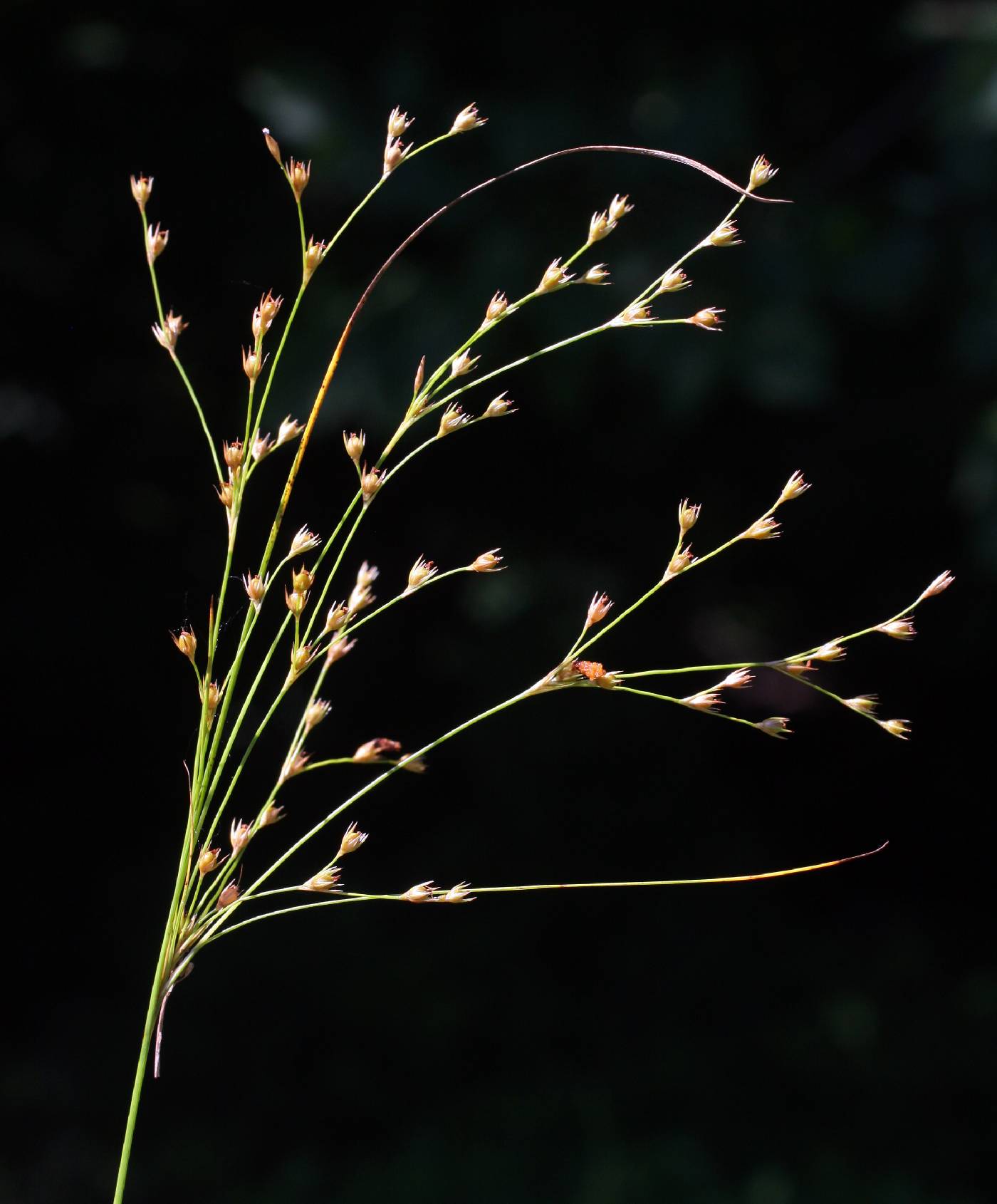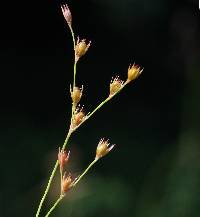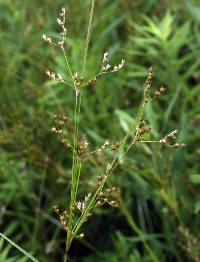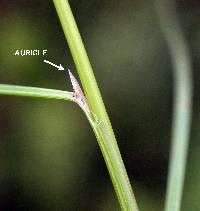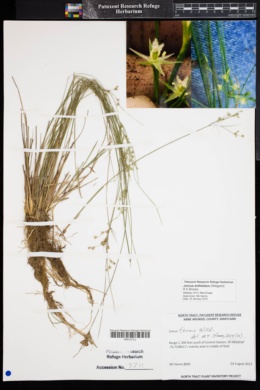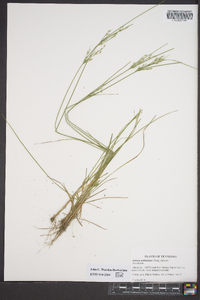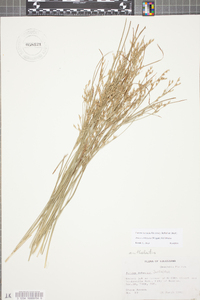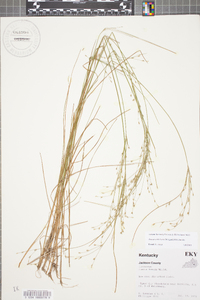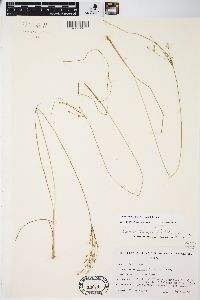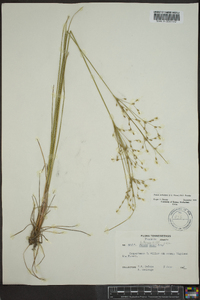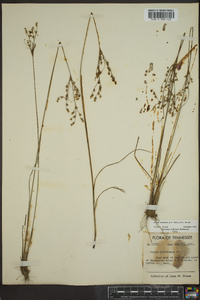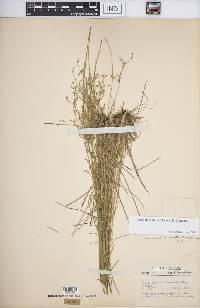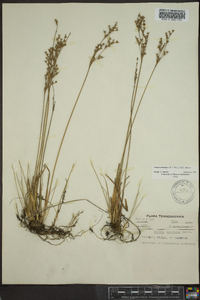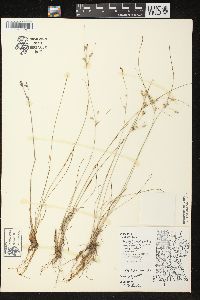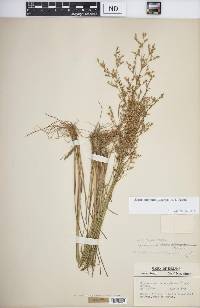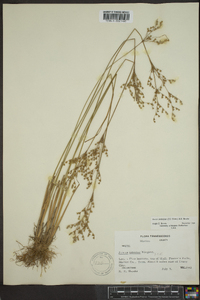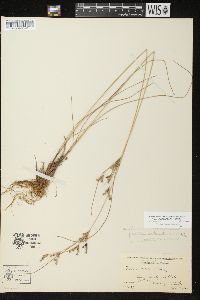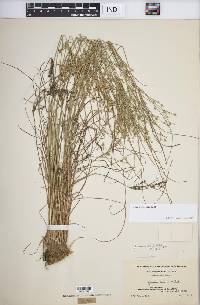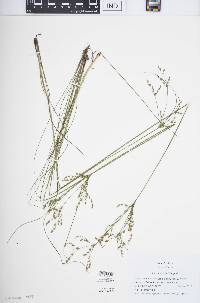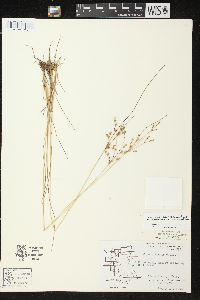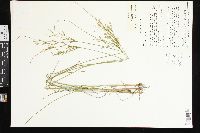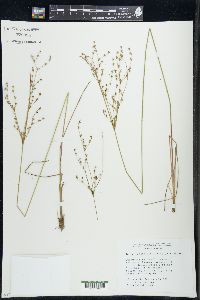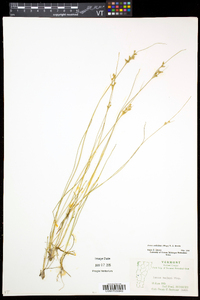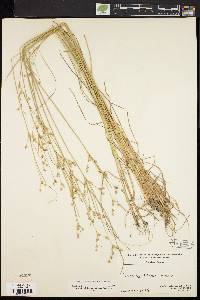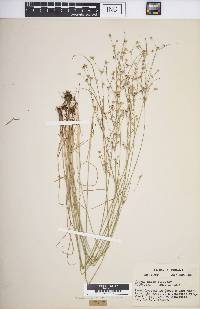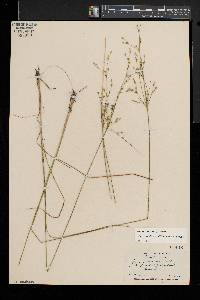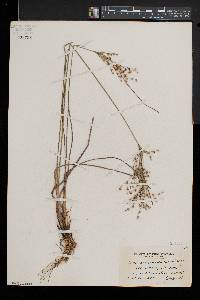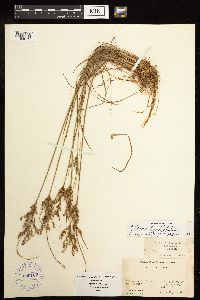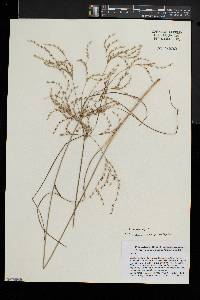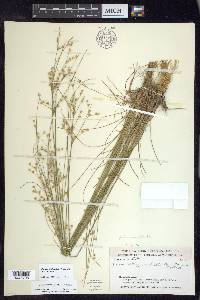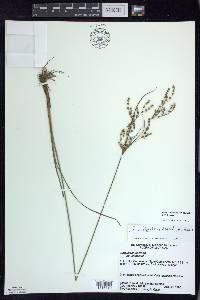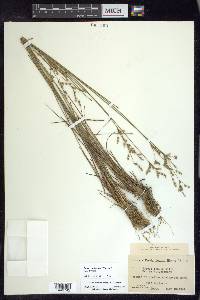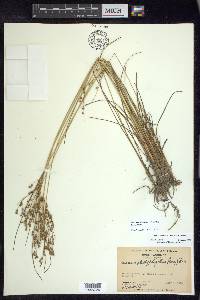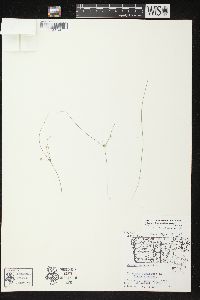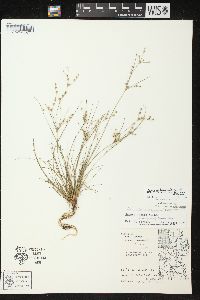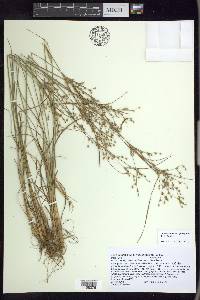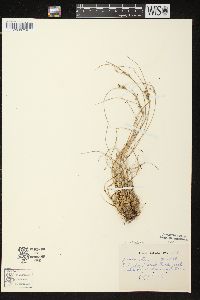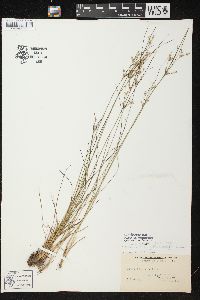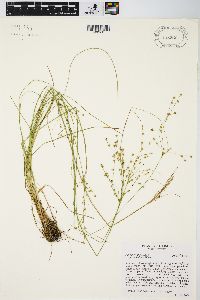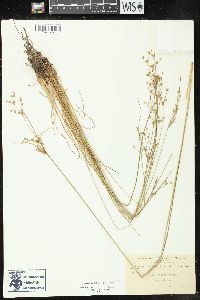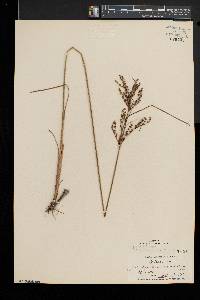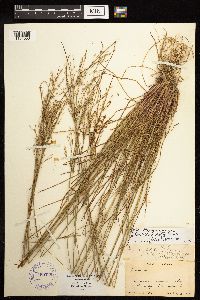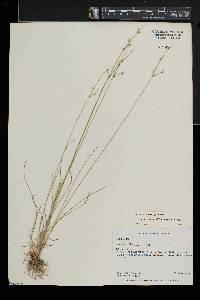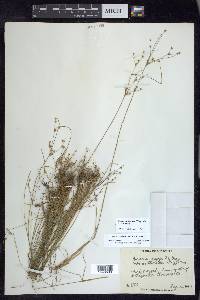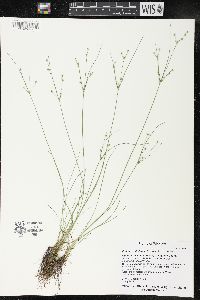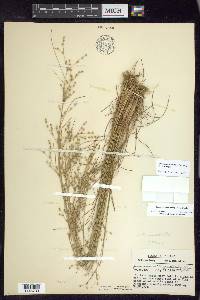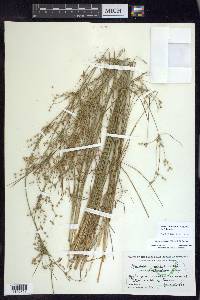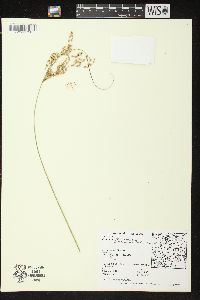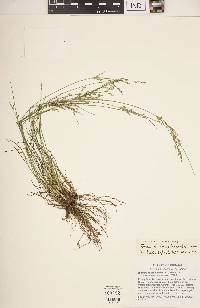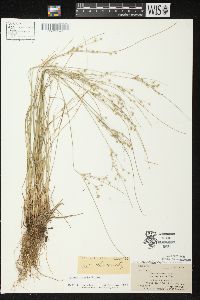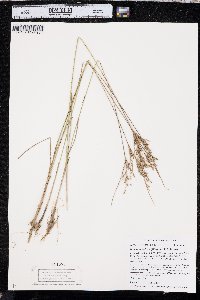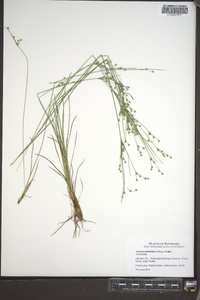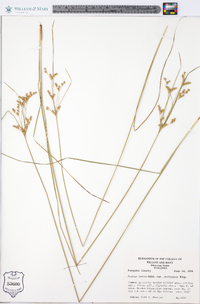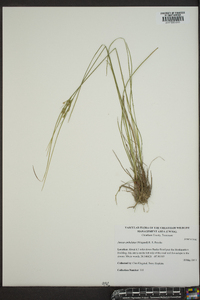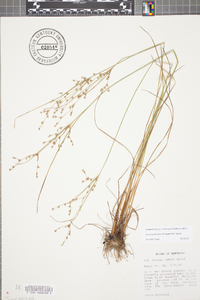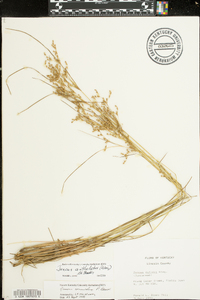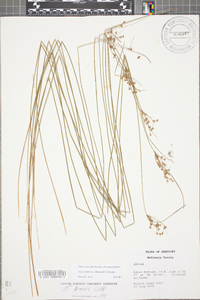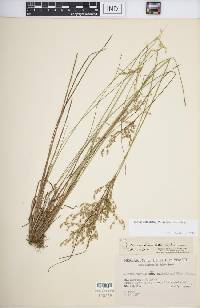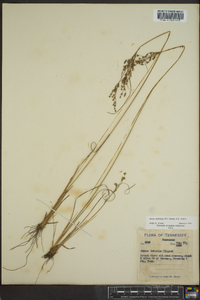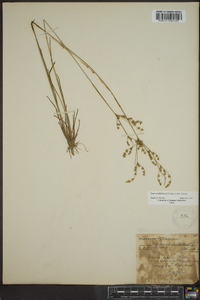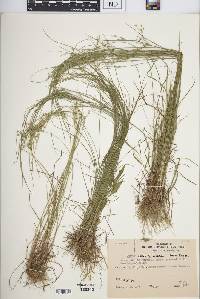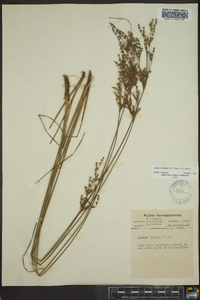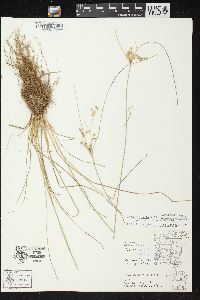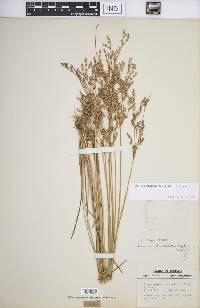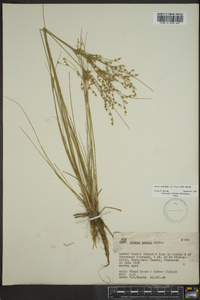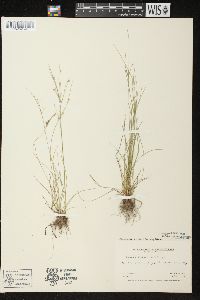
|
|
|
|
Family: Juncaceae
Kentucky Rush, more...greater poverty rush
[Juncus macer f. anthelatus (Wiegand) F. J. Herm., moreJuncus macer f. discretiflorus F. J. Herm., Juncus macer var. anthelatus (Wiegand) Fernald, Juncus tenuis f. discretiflorus (F. J. Herm.) Fernald, Juncus tenuis var. anthelatus Wieg.] |
Herbs, perennial, cespitose, to (3--)7--9 dm. Cataphylls 1--2. Leaves basal, 2--3(--5); auricles transparent, 2--3.5 mm at summit of leaf sheath, apex acutish, membranous; blade flat, (10--)20--30 cm x 0.5--2.3 mm, margins entire. Inflorescences 10--100-flowered, diffuse; internodes of monochasia greater than 6 mm, primary bract usually exceeding inflorescence. Flowers: pedicels 0.1--0.3(--3) mm; bracteoles 2; tepals green, lanceolate, 3.2--4.5 x 0.7--1 mm; outer and inner series nearly equal, in fruit apically erect; stamens 6, filaments 0.8--1.1 mm, anthers 0.3--0.7 mm; style 0.2 mm. Capsules tan, 1-locular, widely ellipsoid to obovoid, 2--3.2 x 1.1--1.6 mm. Seeds tan, ellipsoid, 0.33--0.556 mm, not tailed. 2n = 80. Flowering and fruiting spring. Exposed or partially shaded sites in moist or seasonally wet, sandy or clay soils; Alta., B.C., Man., N.B., Nfld. and Labr., N.W.T., N.S., Ont., P.E.I., Que., Sask., Yukon; Ala., Alaska, Ariz., Ark., Calif., Colo., Conn., Del., D.C., Fla., Ga., Idaho, Ill., Ind., Iowa, Kans., Ky., La., Maine, Md., Mass., Mich., Minn., Miss., Mo., Mont., Nebr., Nev., N.H., N.J., N.Mex., N.Y., N.C., N.Dak., Ohio, Okla., Oreg., Pa., R.I., S.C., S.Dak., Tenn., Tex., Utah, Vt., Va., Wash., W.Va., Wis., Wyo. Perennial grasslike forb 30 - 90 cm tall Leaves: two to four, basal, 15 - 30 cm long, 0.5 - 2.3 mm wide, slender, grasslike, flattened in cross section, and lacking crosswise partitions inside (non-septate). The leaves also have a fragile, easily broken, transparent, membranous, basal, 2 - 3.5 mm long, pointed-tipped, ear-like appendage (auricle) at the top of the clear-edged leaf sheath. Inflorescence: a terminal, widely spreading, often flat-topped, forked, multi-branched structure with ten to one hundred, single, short-stalked (0.1 - 0.5 mm), radially symmetric, small flowers at the ends of at least 0.6 cm long secondary branches. The entire branched inflorescence is subtended by a large (usually longer than full inflorescence), erect or ascending bract, and the individual stalked flowers have two small bracts (bracteoles) positioned directly below the tepals. Stamens: six, with 0.8 - 1.1 mm long filaments, and 0.3 - 0.7 mm long anthers. Pistil: with one superior ovary, a 0.2 mm long style, and three stigmas. Fruit: single-chambered, tan, 2 - 3.2 mm tall (obviously shorter than tepals), 1.1 - 1.6 mm wide, widely ellipsoid to inversely egg-shaped, distinctly stalked capsules borne widely spaced along spreading branches. Each capsule is surrounded by the erect, remnant tepals. Stems: tufted, erect, smooth, round in cross section. Seeds: many, tan, 0.3 - 0.6 mm long, ellipsoid with short-pointed or abruptly narrowed tips, but without distinct narrowed tails at the ends. Tepals: six in two whorls of three, green, 3.2 - 4.5 mm long (all about same length), 0.7 - 1 mm wide, lance-shaped with pointed tips. Similar species: Juncus anthelatus is most similar to J. tenuis, but that species is typically smaller (rarely to 70 cm tall), and it has taller capsules (3.3 - 4.4 mm) borne on shorter and more congested inflorescence branches. Also very similar are J. dudleyi and J. interior, except neither of those species have long, pointed, fragile ear-like appendages (auricles) at the summit of the leaf sheaths, rather the auricles are well under 1 mm long and hard or even leathery. Other species such as J. vaseyi and J. greenei differ by having leaves that are almost round in cross section. The non-native J. compressus should be obviously differentiated by its much shorter auricles (only up to 0.5 mm), blunt-tipped tepals, and darker colored capsules. Flowering: spring Habitat and ecology: Not common, typically in moist or seasonally wet and usually sandy soil. Occurence in the Chicago region: native Notes: Older treatments often consider this species as a variety of J. tenuis, to which it is very closely related and often confused. Etymology: Juncus is the classical name for Rush. Anthelatus is Latin for "bring in advance" or "place before". Author: The Field Museum From Flora of Indiana (1940) by Charles C. Deam Common in most of the habitats of the species but usually in wetter soils. It is more often found in ditches and low fallow fields and on borders of swamps or ponds than is the species and much less frequently along paths or dry roadsides. …… Indiana Coefficient of Conservatism: C = 0 Wetland Indicator Status: FACW |

